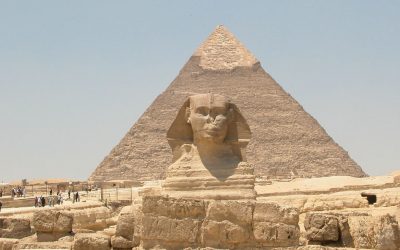Rain and Rivers: Divine Works and Religious Waters
The Timkat Festival in Bahir Dar, Ethiopia. Photo by Terje Oestigaard
By Terje Oestigaard
Water has a fundamental place in most religions, and the ways in which religious waters work in society and in the cosmos reveal human interactions with their gods, as well as with the divine agencies within each religion. Different types of waters are used across religions, such as ‘holy water’, sacred rivers, and rain. Our understanding of how these waters work within religions depends on how we define religion. Approaching and defining religion is difficult, but one can often distinguish between two approaches: one emphasising function, or one emphasising substance.
The most omnipresent divine waters throughout history, irrespective of religions, is not ‘holy’: it is rain.
Functional approaches stress the outcomes and solutions to problems, which divinities may solve, like ending a drought or enabling the purification of body and soul, leading to salvation and eternal life in heaven. It is focused on results, and understands religion as being interwoven with society and psychology.
The substantive approach, on the other hand, focuses on the divine substances and the ontological realities of gods, divinities and ancestors. An example of this view is when Augustine said that religion means ‘worship of God.’
Different types of water combine these approaches. Holy water cannot work without active gods, which points to a substantive approach, and rainmaking rituals depend on benevolent divinities and ancestors, which also puts emphasis on the rituals being conducted, and points to a functional approach.
While holy water is common and most often associated with religious waters, it is worthwhile to stress that the most omnipresent divine waters throughout history, irrespective of religions, is not ‘holy’: it is rain. Rain is fundamentally linked to agriculture and the seasonal cycles. The importance of rain for farmers is a matter of life and death, and although the Hebrew and Christian God is not a traditional rain-god, he has given benevolent rain to the blessed, and also withheld the precious water as a penalty whether as rain or river.
In the Bible, God’s powers and uses of water are made explicit. The Lament over the River Nile is described in Isaiah 19:5–10: “The waters will fail from the sea, And the river will be wasted and dried up. The rivers will turn foul; The brooks of defense will be emptied and dried up; The reeds and rushes will wither[…].” In contrast, Israel or the Promised Land is hailed as a land of hills and valleys, “which drinketh water of the rain of heaven.” Israel was a country of benevolent waters. In Deuteronomy (11:10–13), it says: “The land you are about to cross into and possess, a land of hills and valleys, soaks up its water from the rains of heaven. It is a land which the Lord your God looks after, on which the Lord your God always keeps his eye, from year’s beginning to year’s end.”
In Islam, the Qur’an (21:30) says: “We made from water every living thing,” summing up the all importance of water in Islam. It also says “Consider the water which you drink. Was it you that brought it down from the rain cloud or We? If We had pleased, We could make it bitter: why then do you not give thanks?” (56:68-70). Water is a divine gift and the benefits are clearly expressed: “We send down pure water from the sky, that We may thereby give life to a dead land and provide drink for what We have created — cattle and men in great numbers” (25:48-49).
The powers and penalties of divinities giving or withholding the life-giving waters, and the human importance of the right amount of rain at the right time for a successful harvest as a matter of life and death is fundamentally within the cosmological realm. Such perceptions are not restricted to ‘traditional’ religions, but relate directly to religious ecologies and to what extent societies at large are fundamentally dependent upon the life-giving rains for successful harvest. If, on the other hand, society and farmers are irrigating and depending upon the annual inundation and the rivers to flood, there is a greater chance that this water is perceived as holy.
Holy water has thus distinct qualities and divine powers compared to divine waters like the life-giving rains. The unique character of holy water is precisely that the religions’ respective divinity has invested or ‘activated’ the particular water with divine substance. It is holy because it contains parts of the divinities’ power and as such it may have different religious powers for specific cosmological purposes. The water used in the daily ablutions among Muslim devotees is for purification, the water in the Christian baptism symbolises the entry into Kingdom of God and the promise of salvation, and the most omnipotent and omnipresence of holy water is found in Hinduism and the river Ganges — the mother and goddess Ganga.
This river is both the goddess and a holy bath washing away and erasing sins and impurities, enabling salvation. The power of this extremely holy and powerful water enabled the largest ever gathering of people on earth. In 2013, the Kumbh Mela in Allahabad was exceptional and the ultimate pilgrimage: it was the Maha Kumbh Mela, which happens only once every 144 years. A purna (full) kumbh is held every 12 years, and after 12 purna kumbhs, the Maha Kumbh takes place. Altogether, it is estimated that 120 million pilgrims and devotees came to the holy waters at the confluence, and at the most auspicious day, February 10, an estimated 30 million took holy bath purifying themselves at this cosmic place at this cosmic time.
Thus, holy water is characterized by several processes and premises; it is a pilgrimage, it is purifying, and it is primarily personal. Rain, on the other hand, is also another form of divine water, but it is mainly collective and for the benefit of society, enabling bountiful harvests, and gods may also penalise people and society by withholding the life-giving waters. Different divine works are therefore often expressed and manifested in religious waters, because it affects everyone at all times: from the farming activities providing food on the table, to the promise of salvation and eternal life in the afterlife. The divine waters incorporate not only everything from the cradle to the grave, but they also link the cosmic water of creation to eternal life in paradise, and put emphasis on how humans interact with their divinities. We can use both functional and substantive approaches to understanding religion when we examine the use of divine waters around the globe.
Terje Oestigaard is an archaeologist, researcher and Docent at the Department of Archaeology and Ancient History, Uppsala University, Sweden. Since 2006, he has worked with the Nile basin countries and conducted fieldworks in Egypt, Ethiopia, Tanzania and Uganda. Previous to his research in Africa, he conducted contemporary and archaeological fieldworks in Bangladesh, Greece, Jordan, India, Nepal, Palestine as well as in Scandinavia. He is also the author of The Religious Nile. Water, Ritual and Society since Ancient Egypt (I.B. Tauris, London, 2018).



